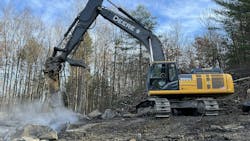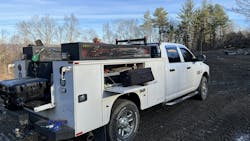One of the most advantageous uses for AI in the construction industry so far is safety and the protection of assets.
Managing physical operations is increasingly challenging due to rising costs, labor shortages, safety concerns, outdated tech, and sustainability demands.
An AI technology company, Motive, surveyed leaders across trucking and logistics, construction, oil and gas, and more to gain deeper insights into the challenges faced by leaders in physical operations over the past year, as well as the opportunities that lie ahead.
They call the survey a “Physical Economy Outlook.” The firm queried 1,000 physical operations leaders of commercial fleets of at least 100-plus vehicles across 11 industries “that power the physical economy.”
Motive found that the typical management team is small, juggling a multitude of tasks that pose a constant challenge to protect their workers, vehicles, and assets. Overwhelmed teams, Motive says, are looking for a lifeline that can be found in technology and advancements in AI.
Over a third of leaders reported that operational inefficiencies are a roadblock and 1 in 4 are struggling with outdated technology and software. And they’re losing money. On average, organizations surveyed lost $867,634 due to rising costs, labor shortages, talent retention, supply chain disruptions, and the inefficiencies.
Fragmented data, disparate tools
Forty-two percent of leaders told Motive they lack a single view into their workers, vehicles, assets/equipment, and spending/payments. Some 46% of leaders said they are using more than 10 individual tools to manage operations with 30% saying they have too many to count.
The survey also revealed a hidden problem—fraud. Leaders agree (44%) that fraud is having a “big” impact on their businesses but are not sure where to find it. They are uncertain about how much fleet spend is lost to fraud. Estimates run up to 19% with construction leaders saying it’s even higher at 22%.
Motive says 38% of leaders are looking at AI to help with fraud detection and prevention. Spending and reporting are two areas of concern.
Investing in updates and AI
Leaders surveyed are sounding the alarm on their own technology, with 40% saying their current tech is unreliable and inaccurate. Zeroing in, their top complains are the lack of a comprehensive operational view (42%) and privacy and data security concerns (42%).
It comes as little surprise that 80% of leaders agree that having a single, end-to-end solution to manage physical operations would make their job easier.
What leaders want
Here are the top areas leaders see AI as bringing the most value:
- Tracking assets and vehicles, 43%
- More accurate decision making, 40%
- Expense planning, 39%
- Reducing admin work, 39%
- Detecting fraud, 38%
- Anticipating demand, 37%
Seventy-three percent of leaders agree that roads are safer with AI enabled cameras/dashcams, and 64% say AI is “crucial” for preventing accidents and coaching drivers.
Technology offerings such as the company’s AI Omnivision are designed to address many of the concerns raised in the survey.
It is a general-purpose computer vision platform for physical operations. It uses AI-powered software to deliver visibility to all facets of an operation, leveraging the capabilities of Motive’s AI Omnicam.
Specifically for construction, users can visually monitor and automatically alert managers in real-time of job site hazards such as workers not wearing personal protective equipment, which is a major driver of workplace fatalities.
With trucks and cargo, it spots unauthorized movement of cargo and tracks unauthorized access or theft, as well as alerting a driver or manager in real time if cargo is improperly tied down.
Smaller assets and equipment on job sites, in warehouses, and in transit can now be tracked with Motive Beacon.
The Motive Beacon is a small Bluetooth-based tracking device that allows customers to track just about anything—from small tools and equipment on a worksite to pallets in a warehouse. The Beacon connects to the Motive Beacon Gateway to enable meter-level indoor positioning and connects to the Motive Mesh Network to allow customers to track their equipment on the move.
Indoors and out
Indoors, the Beacon Gateway is designed specifically for asset positioning within a facility such as a warehouse, manufacturing plant, or construction site, where traditional GPS tracking is unreliable. By connecting Motive Beacons to the Motive Beacon Gateway, it creates a wireless technological net that enables workers to leverage the Motive Fleet App to lead them precisely to the asset they need.
Once an asset is in transit outdoors beyond the confines of a facility, the Motive Mesh Network leverages the company’s 2 million+ active Motive Vehicle Gateways, Asset Gateways, and Motive App users to locate these assets. This ensures that all assets are accounted for and significantly reduces the cost associated with lost inventory.
Finally, Driver Safety Solution with First Responder functionality dispatches emergency services in the event of a severe collision. When a severe collision occurs, Motive has key data like vehicle location, make, model, color, license plate, orientation, passengers, and other important information to provide emergency services while simultaneously notifying the safety manager of the collision.
“We’re executing on our vision of one integrated platform that combines Driver Safety, Spend Management, Fleet Management, Equipment Monitoring, and now AI Omnivison, all in one place,” said Shoaib Makani, Motive co-founder and CEO. “And with our continued investment in AI and computer vision, we’re automating even more manual work so our customers can focus on the people and things that matter most.”
About the Author
Frank Raczon
Raczon’s writing career spans nearly 25 years, including magazine publishing and public relations work with some of the industry’s major equipment manufacturers. He has won numerous awards in his career, including nods from the Construction Writers Association, the Association of Equipment Manufacturers, and BtoB magazine. He is responsible for the magazine's Buying Files.




